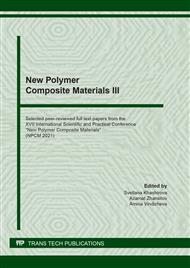[1]
R. Narain, Polymer Science and Nanotechnology Fundamentals and Applications, Elsevier, (2020).
Google Scholar
[2]
S. Mohan, O.S. Oluwafemi, N. Kalarikkal, S. Thomas, S.P. Songca, Biopolymers – Application in Nanoscience and Nanotechnology, Headquarters Intech Open Limited, London, (2016).
DOI: 10.5772/62225
Google Scholar
[3]
Y. Luo, Q. Wang, Y. Zhang Biopolymer-Based Nanotechnology Approaches to Deliver Bioactive Compounds for Food Applications: A Perspective on the Past, Present, and Future. Journal of Agricultural and Food Chemistry 68 (46) (2020) 12993-13000.
DOI: 10.1021/acs.jafc.0c00277
Google Scholar
[4]
S. J.Alund, , G.Smistad, , M. Hiorth,. A multivariate analysis investigating different factors important for the interaction between liposomes and pectin, Colloids Surf. A: Physicochem. Eng. Aspects 420(0) (2013) 1–9.
DOI: 10.1016/j.colsurfa.2012.11.079
Google Scholar
[5]
J. R.Andrade, , E.Raphael, A Pawlicka.. Plasticized pectin-based gel electrolytes, Electrochim. Acta, 54(26) (2009), 6479–6483.
DOI: 10.1016/j.electacta.2009.05.098
Google Scholar
[6]
M. M Baracat, A. M Nakagawa., R Casagrande., et al. Preparation and characterization of microcapsules based on biodegradable polymers: Pectin/casein complex for controlled drug release systems, AAPS PharmSciTech, 13(2) (2012) 364–372.
DOI: 10.1208/s12249-012-9752-0
Google Scholar
[7]
M. F Basanta., N. M. A Ponce., et al. Effect of extraction time and temperature on the characteristics of loosely bound pectins from Japanese plum, Carbohydr. Polym., 89(1) (2012) 230–235.
DOI: 10.1016/j.carbpol.2012.03.001
Google Scholar
[8]
K Bélafi-Bakó., P. Cserjési, S Beszédes, et al. Berry pectins: Microwave-assisted extraction and rheological properties, Food Bioprocess Technol., 5(3) (2012) 1100–1105.
DOI: 10.1007/s11947-011-0592-9
Google Scholar
[9]
Blaut, M. (2002). Relationship of prebiotics and food to intestinal microflora, Eur. J. Nutr., 41 Suppl 1, I11–I16.
Google Scholar
[10]
M. M Bomgardner.. Pushing pectin, Chem. Eng. News, 91(29) (2013), 20.
Google Scholar
[11]
E. Bouyer, G Mekhloufi., V Rosilio et al. Proteins, polysaccharides, and their complexes used as stabilizers for emulsions: Alternatives to synthetic surfactants in the pharmaceutical field?, Int. J. Pharm., 436(1–2) (2012) 359–378.
DOI: 10.1016/j.ijpharm.2012.06.052
Google Scholar
[12]
B Chen., D.J. Mcclements, et al. Stabilization of soybean oil bodies by enzyme (laccase) crosslinking of adsorbed beet pectin coatings, J. Agric. Food Chem., 58(16) (2010), 9259–9265.
DOI: 10.1021/jf102082u
Google Scholar
[13]
J Chen., R.-H Liang et al., Pectic-oligosaccharides prepared by dynamic highpressure microfluidization and their in vitro fermentation properties, Carbohydr. Polym., 91(1) (2013), 175–182.
DOI: 10.1016/j.carbpol.2012.08.021
Google Scholar
[14]
J Chen, R. H Liang., et al., Extraction of pectin from Premna microphylla turcz leaves and its physicochemical properties, Carbohydr. Polym., 102 (2014), 376–384.
DOI: 10.1016/j.carbpol.2013.11.069
Google Scholar
[15]
P Di Pierro, Marquez, G Rossi, et al., Effect of transglutaminase on the mechanical and barrier properties of whey protein/pectin films prepared at complexation pH, J. Agric. Food Chem., 61(19) (2013), 4593–4598.
DOI: 10.1021/jf400119q
Google Scholar
[16]
K. A.Edwards, , and A. J. Baeumner, Analysis of liposomes, Talanta, 68(5) (2006) 1432–1441.
DOI: 10.1016/j.talanta.2005.08.031
Google Scholar
[17]
J.-P Ele-Ekouna., C.P au-Roblot, et al., Chemical characterization of pectin from green tea (Camellia sinensis), Carbohydr. Polym., 83(3) (2011)., 1232–1239.
DOI: 10.1016/j.carbpol.2010.09.028
Google Scholar
[18]
R. S. Faravash, F. Z Ashtiani.. The influence of acid volume, ethanol-to-extract ratio and acid-washing time on the yield of pectic substances extraction from peach pomace, Food Hydrocolloids, 22(1) (2008), 196–202.
DOI: 10.1016/j.foodhyd.2007.04.003
Google Scholar
[19]
Fraeye, I., Doungla, E., Duvetter, T., Moldenaers, P., Van Loey, A., and Hendrickx, M. (2009). Influence of intrinsic and extrinsic factors on rheology of pectin–calcium gels, Food Hydrocolloids, 23(8), 2069–(2077).
DOI: 10.1016/j.foodhyd.2009.03.022
Google Scholar
[20]
T Fukunaga, M. Sasaki, Y Araki, et al., Effects of the soluble fibre pectin on intestinal cell proliferation, fecal short chain fatty acid production and microbial population, Digestion, 67(1–2) (2003), 42–49.
DOI: 10.1159/000069705
Google Scholar
[21]
L. Geng, W Zhou, X Qu, W. Chen, et al., Optimization of the preparation of pectin from Aloe using a Box–Behnken design, Carbohydr. Polym., 105(0) (2014) 193–199.
DOI: 10.1016/j.carbpol.2014.01.069
Google Scholar
[22]
D.A. Slobodova, R.M Gorshkova, V.Y. Elohovski, et al., Some aspects of the practical application of cryophylactic media based on oligosaccharides Vestnik SPGUTD. Series 1. Natural and technical sciences, N 3 (2020) 91-97.
Google Scholar
[23]
D.A. Slobodova, R.M Gorshkova, N.P. Novoselov, et al., Kinetics of Sequential Protopectin Degradation in a Flowing Reaction Solution. Fibre Chem 52, 291–296 (2020).
DOI: 10.1007/s10692-021-10199-w
Google Scholar


